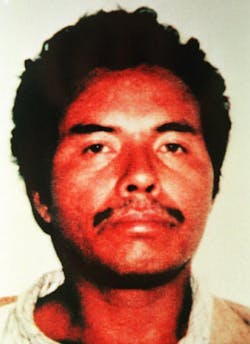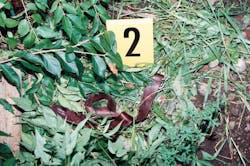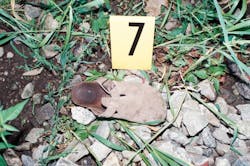How to Catch A Criminal: From the Other Side of the Tracks
I bring you this column out of my pure fascination with police work, cold cases, forensics, interrogation, and all things criminal and mysterious. As an active-duty police officer, I hold an interest in all cases especially those that bring justice to light in the end. The purpose of this column is to tell the story of cases which were solved by technological advancements, unconventional tactics, dumb luck, and any other manner outside the norm. I hope you find these cases as intriguing and motivating as I do. This month, a repeatedly deported criminal who exploited flaws in the immigration system to murder his way through six states.
During the Great Depression, unemployment and poverty skyrocketed, leaving millions without a way to support themselves and their families. This led to the popularization of the hobo lifeStyle. Often used to refer to transient bums, “hobo” is actually a term used for a migrant worker. Hobos would travel in search of work and a better life, moving from place to place as opportunities dried up. Due to their impoverishment, hobos could not afford cars, bus tickets or train tickets. It quickly became common practice for hobos to hop onto passing train cars, riding them wherever they might go, in hopes of work, adventure, and an escape from the crushing heel of the slow-recovering economy. As the nation finally rebounded from the Great Depression in the 40s, the hobo way of living mostly died out, as joblessness shrunk, and there was opportunity abound in all areas of the United States. Today, there are still some people who partake in the hobo life, including “riding the rails” to get around. Unfortunately, this method of travel lends itself to criminals as well, as they can quickly and quietly cross state lines as a train car stowaway.
This article appeared in the July issue of OFFICER Magazine. Click Here to view the digital edition. Click Here to subscribe to OFFICER Magazine.
Bexar County, Texas, March 23, 1986. The body of an unknown female was discovered in a farmhouse, shot to death by four rounds from a .38 caliber handgun. Years later, on July 19, 1991 the body of 22-year-old Michael White was found in the front yard of a San Antonio home, bludgeoned to death. Aside from proximity, these two crimes appeared completely unrelated. Six years later and several states away however, two more murders occurred, and they were definitely related. In Ocala, Florida, on March 23, 1997, young couple Jesse Howell and Wendy Von Huben were murdered. Nineteen-year-old Howell was beaten to death with a brass coupling from a train car, and his body was left near the tracks. Thirty miles from Jesse’s body, 16-year-old Wendy Von Huben was buried in a shallow grave after being raped and strangled. It is believed Howell and Von Huben were planning to hop onto a train car to travel home to Illinois after having a string of bad luck on a road trip. It was near the tracks that they encountered their killer.Mere months later and many miles away, a 54-year-old transient man named Roberto Castro was beaten to death in a railyard. Castro was killed on July 5, 1997 in Colton, California. Similarities were beginning to show in these cases, however there was still nothing to indicate these murders were anything more than less fortunate people who met unfortunate ends. It would soon become evident that all of these slayings were the work of the same person, who would become known as The Railroad Killer.
In August of 1997, a college couple left a party in Lexington, Kentucky to take a quiet walk together. As they came to some nearby train tracks, they encountered The Railroad Killer. He approached them and demanded money. They offered up what they had in the hopes he would leave them alone, but sadly he wanted more than their money. Christopher Maier and his girlfriend, Holly Dunn, were both tied up before Maier was bludgeoned to death with a 52-pound rock. Dunn was then raped and beaten, left for dead. For the first time, The Railroad Killer didn’t go far enough, and Holly Dunn survived her attack, and was able to run to a nearby home to get help when she awoke. Dunn would become the only known person to survive an encounter with The Railroad Killer.
The attack on Maier and Dunn was enough to satiate the Railroad Killer’s desires for over a year, until Oct. 4, 1998. The Railroad Killer made his way to Hughes Springs, Texas and entered the home of 87-year-old Leafie Mason through a window. Leafie was found dead, beaten with a fireplace tool. On Dec. 10, of the same year, in Carl, Georgia, 81-year-old Fannie Byers was found beaten to death in her home. Byers home was, of course, located close to railroad tracks. Seven days later, in West University Place, Texas, pediatric neurologist Claudia Benton was beaten to death with a statue after being raped and stabbed in her home. During the investigation, police were able to locate fingerprints inside Benton’s car, which the killer apparently tried to steal, as well as DNA from her corpse. The Railroad Killer went quiet again for several months before unleashing a wave of terror on the state of Texas through the spring and summer of 1999. On May 2, 1999, the Minister of the Weimar United Church of Christ, Norman Sirnic, and his wife Karen, were bludgeoned to death with a sledgehammer inside the clergy house behind the church in Weimar, Texas. The clergy house was in close proximity to railroad tracks.As this information was uncovered, it was also clear that beginning in 1976, Resendiz had been deported more than a dozen times before once again illegally entering the U.S. Often times he would cross the border again within days of deportation. At various times he had been in the custody of Border Patrol, Immigration and Naturalization Services, Texas Department of Public Safety and several other law enforcement agencies. Due to lapses in communication between different AFIS systems and other identification networks, Resendiz was able to carry out his crimes in the U.S. for nearly 25 years before authorities discovered he was a repeat offender, hiding behind fabricated identities.
The FBI-led “Operation Trainstop” was a taskforce dedicated to searching for Resendiz across the nation’s railroad systems. Though there was no way of telling where Resendiz was or where he would go next, it was clear he was using passing trains to travel, and it wouldn’t be long before he surfaced again. Tips flooded the taskforce, reporting sighting of Resendiz in several states, however a chance encounter with Border Patrol, would lead not only to his apprehension, but his release as well.
On June 2, 1999, Angel Resendiz was arrested after Border Patrol Agents found him walking along train tracks in El Paso Texas without ID. After giving the name Rafael Resendez-Ramirez, his fingerprints were taken. The name Rafael Resendez-Ramirez did not come up with a warning as an alias of Resendiz, so there was no reason for him to be held, and he was again deported back to Mexico. He returned to the U.S. only days later. On June 4, 1999, 26-year-old Noemi Dominguez, an elementary school teacher, was beaten to death by Resendiz with a gardening hoe inside her Houston apartment. Dominguez’s car was stolen and recovered a week later. Also on June 4, in Dubina, Texas, 76-year-old Josephine Konvicka was murdered, found with the same gardening hoe from the Dominguez murder buried in her head. After leaving Texas, Resendiz road the rails to Illinois where he broke into another home near the tracks on June, 14. Inside the residence was 80 year-old George Morber and his 52-year-old daughter Carolyn Fredrick. Morber was tied up and executed with a shotgun, which was then used to bludgeon Fredrick to death.
Meanwhile, Resendiz’s sister, Manuela Karkiewicz, was located in Albuquerque, New Mexico. Manuela was contacted by Texas Rangers, who informed her Angel could be injured or killed if he was found and tried to resist capture. Manuela was able to contact Angel and convince him to surrender peacefully. Manuela became instrumental in facilitating Angel’s arrest, and even received the $86,000 reward being offered for information that led to his arrest. Manuel and Texas Ranger Drew Carter met Angel Resendiz on a bridge connecting El Paso, Texas and Juarez, Mexico on July 21, 1999. Resendiz shook Carter’s hand and was willingly arrested.
Angel Resendiz’s trial for the murder for Claudia Benton took place in May of 2000. Resendiz entered a plea of not guilty by reason of insanity. Resendiz claimed the people he killed were evil, and he was sent by God to punish them. The plea was rejected and Resendiz was eventually convicted and sentenced to death. In September 2001, The Railroad Killer began confessing to his crimes, revealing previously unknown information, and victims.
The unknown woman he shot in 1986, was accompanied by a male who Resendiz also shot. The male’s identity remains unknown as well, however he was killed and dumped in a creek because Resendiz believed the male was a practitioner of black magic. Wendy Von Huben and Jesse Howell were allegedly not religious enough for Resendiz’s liking, so he murdered them both. He also believed that Caludia Benton, the pediatric neurologist, was performing experiments on children, murdered her as punishment. Noemi Dominguez allegedly had books in her apartment regarding abortion, which led Resendiz to conclude she needed to be killed. No such literature was found at the scene of her death.
After being evaluated by a psychiatrist, he was deemed competent for execution. His death warrant was signed in June 2006. Angel Resendiz insisted he was a soldier of God, handing down judgment to sinful people. He claimed he would live forever and could not be killed, despite his death sentence. On June 27, 2006, The Railroad Killer learned he was indeed mortal when he died by lethal injection. In his final statement, Resendiz stated he had allowed the Devil to deceive him, and begged for forgiveness from God and the families of his victims. Whether forgiven or not, his sins had been judged, and his punishment dealt.
This case is an example of how disparate data systems can hinder efficient closure of capital cases. While much improvement has been made since the 1990s, data management continues to be a challenge for law enforcement.
This article appeared in the July issue of OFFICER Magazine.
About the Author

Officer Brendan Rodela, Contributing Editor
Brendan Rodela is a Sergeant for the Lincoln County (NM) Sheriff's Office. He holds a degree in Criminal Justice and is a certified instructor with specialized training in Domestic Violence and Interactions with Persons with Mental Impairments.



